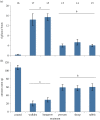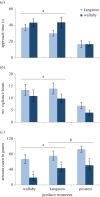Parasite and predator risk assessment: nuanced use of olfactory cues
- PMID: 26468246
- PMCID: PMC4633877
- DOI: 10.1098/rspb.2015.1941
Parasite and predator risk assessment: nuanced use of olfactory cues
Abstract
Foraging herbivores face twin threats of predation and parasite infection, but the risk of predation has received much more attention. We evaluated, experimentally, the role of olfactory cues in predator and parasite risk assessment on the foraging behaviour of a population of marked, free-ranging, red-necked wallabies (Macropus rufogriseus). The wallabies adjusted their behaviour according to these olfactory cues. They foraged less, were more vigilant and spent less time at feeders placed in the vicinity of faeces from dogs that had consumed wallaby or kangaroo meat compared with that of dogs feeding on sheep, rabbit or possum meat. Wallabies also showed a species-specific faecal aversion by consuming less food from feeders contaminated with wallaby faeces compared with sympatric kangaroo faeces, whose gastrointestinal parasite fauna differs from that of the wallabies. Combining both parasite and predation cues in a single field experiment revealed that these risks had an additive effect, rather than the wallabies compromising their response to one risk at the expense of the other.
Keywords: anti-predator behaviour; faecal aversion; foraging behaviour; macropodid marsupials; parasite avoidance; predator detection.
© 2015 The Author(s).
Figures


Similar articles
-
Familiarity breeds contempt: kangaroos persistently avoid areas with experimentally deployed dingo scents.PLoS One. 2010 May 5;5(5):e10403. doi: 10.1371/journal.pone.0010403. PLoS One. 2010. PMID: 20463952 Free PMC article.
-
Host-parasite associations of Eimeria spp. (Apicomplexa:Eimeriidae) in kangaroos and wallabies of the genus Macropus (Marsupialia:Macropodidae).Int J Parasitol. 1989 May;19(3):241-63. doi: 10.1016/0020-7519(89)90135-5. Int J Parasitol. 1989. PMID: 2759765
-
Follow your nose: leaf odour as an important foraging cue for mammalian herbivores.Oecologia. 2016 Nov;182(3):643-51. doi: 10.1007/s00442-016-3678-2. Epub 2016 Jul 2. Oecologia. 2016. PMID: 27368609
-
Olfactory assessment of predation risk in the aquatic environment.Philos Trans R Soc Lond B Biol Sci. 2000 Sep 29;355(1401):1205-8. doi: 10.1098/rstb.2000.0668. Philos Trans R Soc Lond B Biol Sci. 2000. PMID: 11079399 Free PMC article. Review.
-
Do predators influence the behaviour of bats?Biol Rev Camb Philos Soc. 2013 Aug;88(3):626-44. doi: 10.1111/brv.12021. Epub 2013 Jan 24. Biol Rev Camb Philos Soc. 2013. PMID: 23347323 Review.
Cited by
-
Avian and rodent responses to the olfactory landscape in a Mediterranean cavity community.Oecologia. 2019 Sep;191(1):73-81. doi: 10.1007/s00442-019-04487-w. Epub 2019 Aug 17. Oecologia. 2019. PMID: 31422472
-
Choosy cannibals: Targeted consumption of conspecific hatchlings by larval cane toads is triggered by species-specific defensive toxins.Ecol Evol. 2022 Mar 1;12(3):e8655. doi: 10.1002/ece3.8655. eCollection 2022 Feb. Ecol Evol. 2022. PMID: 35261745 Free PMC article.
-
Parasite insight: assessing fitness costs, infection risks and foraging benefits relating to gastrointestinal nematodes in wild mammalian herbivores.Philos Trans R Soc Lond B Biol Sci. 2018 Jul 19;373(1751):20170197. doi: 10.1098/rstb.2017.0197. Philos Trans R Soc Lond B Biol Sci. 2018. PMID: 29866912 Free PMC article. Review.
-
Taking cues from ecological and evolutionary theories to expand the landscape of disgust.Proc Biol Sci. 2024 Dec;291(2036):20241919. doi: 10.1098/rspb.2024.1919. Epub 2024 Dec 4. Proc Biol Sci. 2024. PMID: 39626751 Free PMC article. Review.
-
Parasite avoidance behaviours in aquatic environments.Philos Trans R Soc Lond B Biol Sci. 2018 Jul 19;373(1751):20170202. doi: 10.1098/rstb.2017.0202. Philos Trans R Soc Lond B Biol Sci. 2018. PMID: 29866915 Free PMC article. Review.
References
-
- Lima SL, Dill LM. 1990. Behavioral decisions made under the risk of predation: a review and prospectus. Can. J. Zool. 68, 619–640. (10.1139/z90-092) - DOI
-
- Grenfell BT. 1992. Parasitism and the dynamics of ungulate grazing systems. Am. Nat. 139, 907–929. (10.1086/285366) - DOI
-
- Gunn A, Irvine RJ. 2003. Subclinical parasitism and ruminant foraging strategies: a review. Wildl. Soc. Bull. 31, 117–126.
Publication types
MeSH terms
LinkOut - more resources
Full Text Sources
Other Literature Sources

